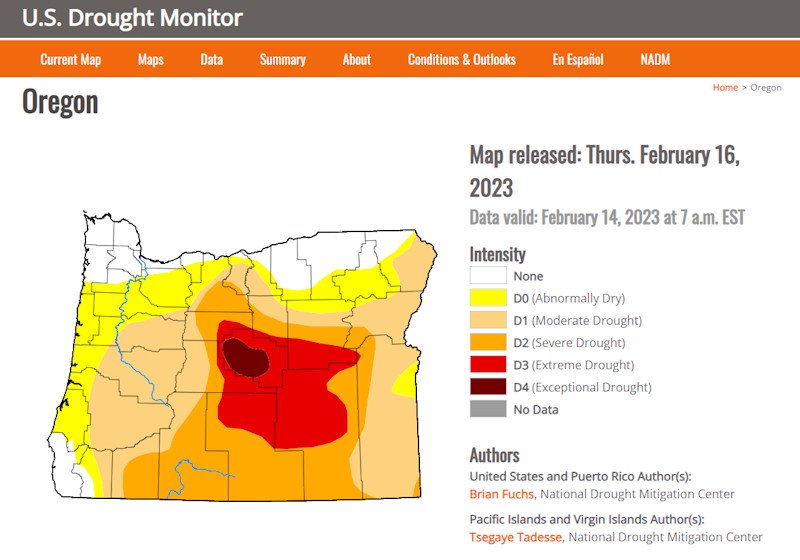Deschutes County declares declares 4th straight drought emergency after state’s Crook, Jefferson county actions

(Update: Deschutes County commissioners OK drought emergency resolution)
By one measure, drought conditions are the worst on record
SALEM, Ore. (KTVZ) – Gov. Tina Kotek last week declared a drought in Crook and Jefferson counties through Executive Order 23-05, and directed state agencies to coordinate and prioritize assistance to the region. It was the state's first drought declaration of the year -- but likely not the last, as Deschutes County on Wednesday took similar action and asked the governor to do the same.
“While this is the first drought declaration of the year, Central Oregon has been facing persistent drought for years due to the ongoing impacts of climate change,” Kotek said. “This is already looking like another challenging drought year for the state, which brings higher risks of wildfires and water shortages. I am committed to ensuring that our agencies are working closely with all partners to get those who are most impacted the help they need.
“Moreover, our state needs to get serious about water resilience moving forward. Our communities, the agriculture sector and our fish and wildlife are all impacted by water scarcity, and we all have to be working together to address the challenges that we are facing today and into the future.”
The drought declaration by Governor Kotek unlocks a number of drought-related emergency tools for water users, including assistance to local water users. Drought declarations also allow the state Water Resources Department to expedite review processes and reduce fee schedules.
All or a portion of Crook County has been classified as having exceptional drought (D4) conditions since early July 2021. The Standardized Precipitation Evapotranspiration Index, a metric to measure drought conditions, indicates the 36-month average ending in January 2023 is by far the worst on record.
Annual water supplies available for water users and instream uses within Crook County are a function of winter snowpack for water storage in Ochoco and Prineville reservoirs and natural flows in the Crooked River and its tributaries. Current conditions in the Crooked River watershed are less than 30% of the average and reservoir storage is only 10% full.
The current U.S. drought monitor has most of Jefferson County mapped in severe to exceptional drought status. Natural flows and reservoir supplies are at or near all-time lows affecting water users and impacting drinking water, fish, wildlife, and instream uses.
The Oregon Drought Readiness Council, a standing body composed of natural resource, public health, and emergency response agencies, received requests from the Crook County Court and Jefferson County Board of Commissioners in January requesting Governor’s drought declarations.
The council received input from Oregon’s Water Supply Availability Committee on regional water supply conditions and Council members have conferred on this matter. The Council recommended that the Governor declare drought in Crook and Jefferson Counties for the 2023 calendar year, pursuant to Oregon Revised Statutes (ORS) 536.740.
As state and local officials coordinate with federal partners, the governor said conditions will be closely monitored by the state’s natural resource and public safety agencies, including the Oregon Water Resources Department and the Oregon Office of Emergency Management.
Deschutes County commissioners approved a resolution Wednesday to declare a countywide state of emergency and request a similar state declaration from the governor -- the fourth consecutive year that step was taken.
NewsChannel 21's Kelsey McGee is talking with county and state officials about the situation; her report is coming up on NewsChannel 21 at Five.
In a staff report, Deschutes County sheriff's Sergeant Nathan Garibay, the county's emergency manager, said precipitation for the water year is now at 80% of normal, the sixth straight year of below-average participation.
Garibay noted that Wickiup Reservoir is just over half of its capacity and is expected to peak around April 1 at near record low levels, while Crescent Lake is at 9% of capacity.
